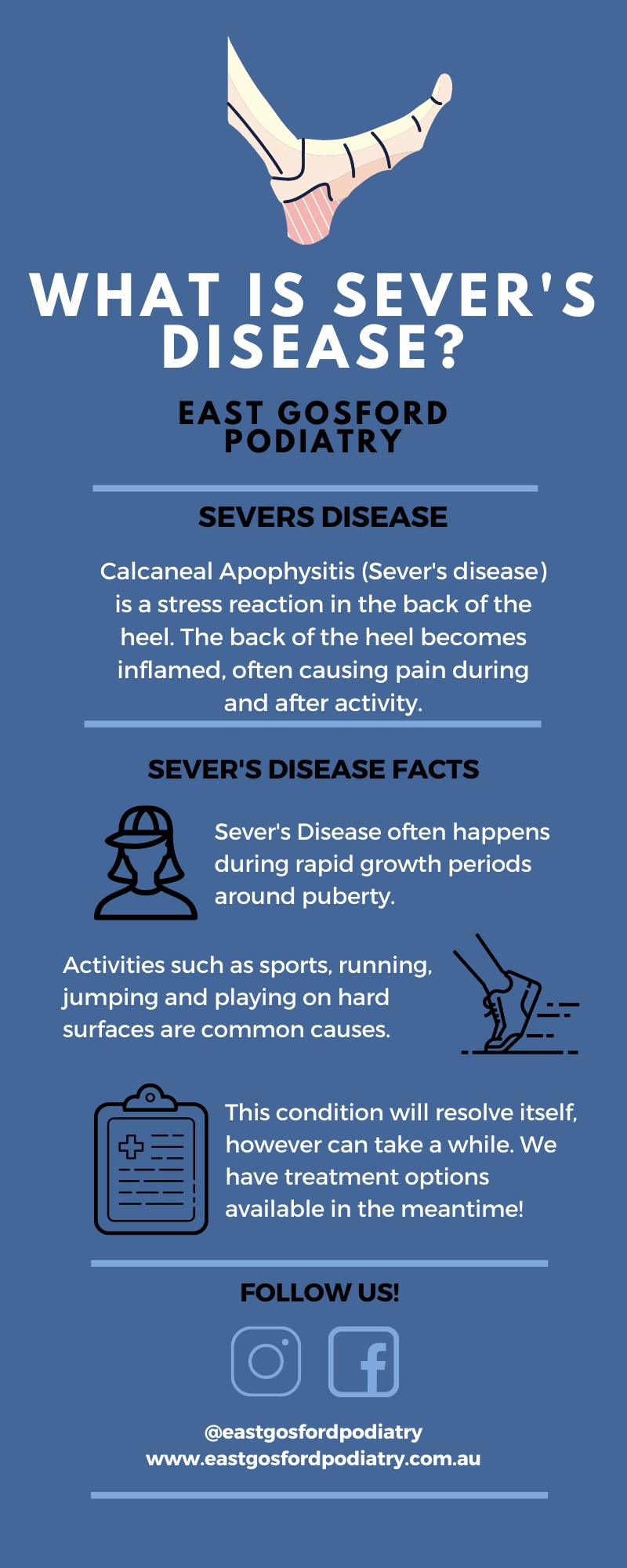What is Sever’s Disease?
Sever’s Disease is also known as calcaneal apophysitis and is commonly found in children. Sever’s disease is a bone injury/stress reaction in the growth plate. This stress reaction then leads to inflammation in the Achilles Tendon, which can cause quite a lot of pain. The pain is felt mostly in the heal and can be caused by excessive traction force from the calf muscles through the Achilles Tendon, and an excessive ground reaction force.
The podiatrists at East Gosford Podiatry are very experienced in diagnosing and treating Sever’s disease. See more about this disease in our infographic below!
Who Can Develop Sever’s Disease?
Sever’s disease is a condition that is most commonly seen in children and adolescents. This is because during this life stage, individuals are experiencing rapid physical growth and this can cause Sever’s disease. Typically, we see a peak of symptoms occurring in:
- Girls: 8-11 years
- Boys 10-13 years
These are the most common times we see patients experiencing symptoms – but it can also occur outside of these ages.
Sever’s Disease Symptoms
There are a few warning signs and symptoms that means your child could have this condition. You will often see the following:
- Pain in one or both heels
- Often the pain is worse in the morning or during the rest period after a high-intensity activity
- Limping
- Showing reluctancy to be involved in vigorous activity
If you see your child exhibiting the above symptoms, it is time to bring them in for an assessment by a qualified podiatrist. We can confirm the presence of the condition by performing a ‘squeeze test’.
Causes Of Sever’s Disease
Sever’s disease is a heel pain condition that typically affects active children during growth spurts, usually between the ages of 8 and 14. It’s caused by repetitive stress on the growth plate in the heel where the Achilles tendon connects to the heel bone.
Here’s a breakdown of the factors involved:
- Growth spurts: During this time, bones, muscles, and tendons grow at different rates. Muscles and tendons can become tight, pulling on the growth plate in the heel.
- Repetitive stress: Activities like running and jumping put extra stress on the heel, especially on hard surfaces. This can irritate the growth plate and cause inflammation.
- Tight Achilles tendon: As bones grow faster than muscles, the Achilles tendon can become tight, adding to the stress on the growth plate.
While these are the main causes, some other factors may also play a role:
- Shoes: Shoes with poor support or worn-out treads can increase the risk of Sever’s disease.
- Being overweight: Extra weight puts more stress on the heels.
It’s important to note that the exact cause of Sever’s disease isn’t fully understood, but these are the established contributing factors.
If your child is displaying symptoms of the condition, we recommend visiting one of our friendly podiatrists at East Gosford Podiatry. We can offer different treatment options that can help alleviate pain and irritation for the child, and back to their fun activities sooner.
East Gosford Podiatry
Here at East Gosford Podiatry on the Central Coast, we have a team of highly skilled podiatrists with vast knowledge on treatment options that can help diagnose and treat Sever’s disease.
This condition is very common in children that can cause quite a lot of pain and discomfort, so implementing effective treatments can help ease the pain and increase the quality of life.
East Gosford Podiatry is very active in the Central Coast Community and surrounding suburbs including Wyoming, Gosford, Terrigal, Green point and Erina. We are passionate about providing comprehensive children’s podiatry care and ensuring that they continue developing healthily. We hope we have answered the question ‘What Is Sever’s Disease?’ and you can learn more about podiatry here.

